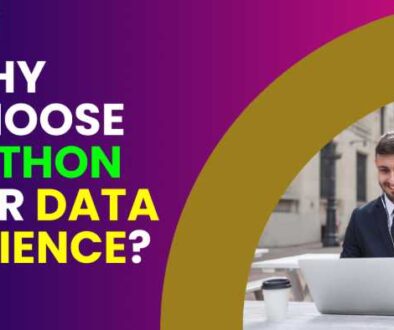Which Python Libraries are Used in Data Science?
In today’s fast-paced, data-driven world, data science has emerged as a crucial field across industries. Python, with its powerful libraries, plays a pivotal role in this domain. It’s the language of choice for many data scientists due to its readability, flexibility, and the extensive range of libraries that simplify complex tasks. For those looking to dive deep into data science, joining a good Python training institute in Pune can provide the skills and hands-on experience necessary to excel. This guide explores essential Python libraries used in data science and highlights the core functionalities that make them invaluable to professionals.
simply looking to enhance your data science toolkit, understanding these libraries will give you a head start. Let’s dive into the world of Python libraries that make data science both accessible and powerful.
Table of Contents
1. NumPy: Foundation of Numerical Computing
NumPy (Numerical Python) is fundamental to numerical and scientific computations in Python. It offers support for multi-dimensional arrays, matrix manipulations, and mathematical functions, making it essential for data science tasks. With NumPy, operations on large datasets become more efficient and manageable.
Key Features:
- High-performance multidimensional arrays.
- Mathematical functions for linear algebra, Fourier transforms, and more.
- Supports large datasets and fast operations.
2. Pandas: Data Manipulation and Analysis
Pandas is a powerful library that facilitates data analysis and manipulation. It is designed to work with structured data effortlessly, offering data structures like Series (1-dimensional) and DataFrames (2-dimensional). Pandas is essential for data cleaning, manipulation, and wrangling—tasks that consume a large portion of a data scientist’s time.
Key Features:
- Handles missing data, making data preprocessing easier.
- Allows merging, grouping, and filtering data efficiently.
Pandas forms the backbone of data handling in Python, and courses focusing on data science will delve into its myriad functions.
3. Matplotlib: Data Visualization
Matplotlib is the go-to library for creating static, animated, and interactive visualizations in Python. It enables data scientists to transform data into visual formats like line plots, bar charts, histograms, and scatter plots.
Key Features:
- Extensive range of customizable charts and plots.
- Integration with Jupyter Notebooks for in-line plotting.
- Supports publication-quality figures for reports and presentations.
Learning data visualization with Matplotlib can greatly enhance your ability to interpret and present data insights.
4. Seaborn: Statistical Data Visualization
While Matplotlib provides a solid foundation for plotting, Seaborn builds on it to offer higher-level functions for creating more aesthetically pleasing and statistically informed visuals. It is especially popular for heatmaps, histograms, and box plots.
Key Features:
- Built on Matplotlib for better visuals and customization.
- Provides easy options for complex visualizations like heatmaps and pair plots.
- In-built themes for cleaner, more sophisticated plots.
In a data science course, learning Seaborn is often paired with Matplotlib to create insightful and visually appealing representations of data.
5. SciPy: Scientific Computing
SciPy, short for Scientific Python, extends NumPy and offers a wide range of functions for scientific and technical computing. It is used for more advanced mathematical operations like optimization, integration, interpolation, and signal processing.
Key Features:
- Provides algorithms for optimization and regression.
- Contains modules for image processing and signal processing.
- Ideal for statistical functions and scientific computation.
For those looking to specialize in scientific data analysis, SciPy is a library you’ll frequently encounter in advanced Python courses in Pune.
. Scikit-Learn: Machine Learning
Scikit-Learn is the library that brings machine learning into the mainstream of Python programming.
Key Features:
- Wide range of supervised and unsupervised machine learning algorithms.
- Tools for model selection, evaluation, and validation.
- Feature engineering and data preprocessing utilities.
For those attending a Python training institute in Pune, Scikit-Learn is a cornerstone of the machine learning curriculum. Its accessible design and comprehensive functionalities make it one of the most widely used libraries in data science.
7. TensorFlow and Keras: Deep Learning Frameworks
TensorFlow and Keras are powerful libraries for implementing neural networks and deep learning models. Developed by Google, TensorFlow is an open-source framework, while Keras, which is a part of TensorFlow, simplifies the development of deep learning models.
Key Features of TensorFlow:
- High-level APIs for building, training, and deploying machine learning models.
- Supports distributed computing for large-scale training.
Key Features of Keras:
- User-friendly API, easy to learn and use.
- Provides a simpler interface to build deep learning models.
- Integrated within TensorFlow for seamless deep learning applications.
Deep learning is becoming increasingly important in data science, and training institutes that offer the best Python classes in Pune are likely to include TensorFlow and Keras in their advanced courses.
8. NLTK and spaCy: Natural Language Processing (NLP)
Natural Language Processing (NLP) is essential for text-based data. NLTK (Natural Language Toolkit) and spaCy are two popular libraries for handling NLP tasks in Python.
Key Features of NLTK:
- Contains a wide range of tools for text processing.
- Provides support for tokenization, stemming, and parsing.
- Includes datasets for training models in NLP.
Key Features of spaCy:
- Fast and efficient, ideal for large-scale NLP applications.
- Supports multi-language models for text processing.
- Provides in-depth tools for named entity recognition, dependency parsing, etc.
9. Statsmodels: Statistical Modeling
Statsmodels is a library dedicated to statistical analysis and hypothesis testing. It provides tools to perform linear and logistic regression, time-series analysis, and other advanced statistical methods.
Key Features:
- Provides in-depth statistical analysis.
- Supports time-series analysis, making it crucial for economic forecasting.
- Offers compatibility with other libraries like Pandas for seamless data handling.
Also Read: Top 12 Python Applications
10. Plotly: Interactive Data Visualization
Plotly is an advanced, interactive graphing library. Unlike Matplotlib and Seaborn, which are static, Plotly enables interactive and dynamic visualizations that can be embedded in web applications.
Key Features:
- Interactive charts for web and mobile applications.
- User-friendly for non-technical audiences with beautiful visuals.
- Provides support for complex visualizations like 3D plots and choropleth maps.
If you’re interested in presenting data interactively or building web dashboards, training in Plotly can be a valuable addition.
11. PyCaret: Automated Machine Learning
PyCaret is an open-source, low-code machine learning library that simplifies the process of building and deploying models. It allows data scientists to automate many of the repetitive tasks in model building.
Key Features:
- User-friendly interface for quick machine learning experiments.
- Supports a wide variety of machine learning algorithms.
- Streamlines model selection and hyperparameter tuning.
As data science becomes more accessible, libraries like PyCaret are gaining attention for their ease of use.
Choosing the Right Python Training Institute in Pune
With so many libraries to master, choosing a Python training institute in Pune with a comprehensive curriculum is essential. Look for institutes that offer hands-on projects, exposure to industry-relevant libraries, and guidance on real-world applications. The best Python classes in Pune will ensure that you gain proficiency in these libraries, giving you the skills to tackle any data science challenge with confidence.
Conclusion
Python’s extensive library ecosystem makes it a versatile and powerful tool for data science. From foundational libraries like NumPy and Pandas to specialized ones like TensorFlow and PyCaret, Python offers everything you need to work effectively with data. Enrolling in Python courses in Pune can provide the structured learning environment needed to master these libraries and become a skilled data scientist. Whether you’re new to data science or looking to upgrade your skills, understanding these Python libraries is the key to a successful career in this exciting field.
Consider joining a Python training institute in Pune today and take the first step towards building a rewarding career in data science. The demand for skilled data scientists continues to grow, and with the right tools and training, you can become a valuable asset in any data-driven organization.




